Mitte September fliegen wir nach Thessaloniki. Von dort fahren wir nach Litorcho, an den Fuß des Olymps.
In mid-September we fly to Thessaloniki. From there we drive to Litorcho at the foot of Mount Olympus.
Olymp-Nationalpark | Olymp National Park
Am Abend kaufen wir im örtlichen Outdoor-Laden eine Karte und bekommen detaillierten Rat für Wanderungen. Am nächsten Morgen laufen wir die Schlucht des Enipeas hinauf. Erst geht es zwei Stunden oberhalb des tief eingeschnittenen Flußes bergauf, dann erreichen wir an einer Brücke das lebhaft fließende Wasser und machen Rast. Dann geht es weiter, vorbei an der Dionysos-Quelle und Kloster bis zum Restaurant in Priona – von dort fahren wir mit dem Taxi zurück zu unserer Unterkunft.
In the evening we buy a map at the local outdoor shop and get detailed advice for hikes. The following day we walk up the gorge of the Enipeas. First, we walk uphill for two hours above the deeply cut river, then we reach the lively flowing water at a bridge and take a break. Then we continue past the Dionysos spring and monastery to the restaurant in Priona – from there we take a taxi back to our accommodation.
Am nächsten Tag fahren wir hinauf zum Parkplatz auf knapp 1200 m Höhe. Wir gehen bergauf, erst durch Mischwald, dann durch einen lichten Buchenwald, der kurz vor der Petrostrougka-Hütte zu einem niedrigen Kiefernwald wechselt. Bei der Hütte auf ca. 2000 m Höhe stehen riesige Bergkiefern. Auf der Hütte übernachten viele Wanderer, um am nächsten Tag weiter auf die Gipfel des Olymp zu steigen.
Wir gehen spontan auf der Rückseite des Hanges über einen sehr schönen einsamen Weg hinunter. Später stellen wir fest, dass der Pfad, der durch ein Tal wieder zum Rücken mit dem Weg zum Parkplatz führt, nicht mehr gepflegt wird – wir müssen die zum Glück noch vorhandenen Wegmarkierungen in teilweise dichtem Wald suchen und uns unseren Weg durch kaum begangenens Gelände bahnen. Mehrmals finden wir unsere Spur nur mit Hilfe der Wander-App (in der der Pfad, genau wie in der vor Ort gekauften Karte, eingezeichnet ist). Da es immer dunkler wird, können wir die Schönheit des einsamen Waldgebietes nicht recht genießen. Im letzten Licht erreichen wir den Weg zum Parkplatz.
Am nächsten Morgen verlassen wir das Olymp-Gebirge und fahren zu den Meteora-Klöstern, südlich des Olymp im Innland des Griechischen Festlandes.
The next day we drive up to the car park at an altitude of just under 1200 metres. We walk uphill, first through a mixed forest, then through a sparse beech forest, which changes to a low pine forest shortly before the Petrostrougka refuge. At the refuge, at an altitude of about 2000 m, there are huge mountain pines. Many hikers spend the night at the hut in order to continue climbing the peaks of Mount Olympus the next day.
We spontaneously walk down the back side of the slope via a very beautiful lonely path. Later we discover that the path that leads through a valley back to the ridge with the path to the car park is no longer maintained – we have to look for the fortunately still existing trail markings in partly dense forest and make our way through hardly trodden terrain. Several times we only find our track with the help of the hiking app (in which the path is marked, just like in the map bought on site). As it gets darker and darker, we can’t quite enjoy the beauty of the lonely forest area. In the last light we reach the path to the car park.
The following day we leave the Olympus Mountains and drive to the Meteora Monasteries, south of Mount Olympus in the interior of mainland Greece.
Meteora-Felsen | Meteora-Rocks
Wir kommen in Kalabaka an und laufen den Fußweg zum Kloster Agía Triáda hinauf. Nach einem kurzen schönen Aufstieg erreichen wir den Weg vom Parkplatz zum Felsenkloster, das bis Anfang des letzten Jahrhunderts nur über Strickleitern oder in einem mit einem Kran mit Handwinde hinaufgezognenen Netz zu erreiche war. Heute fahren Busse Touristen hierher, die sich durch die Klosteranlage drängen.
We arrive in Kalabaka and walk up the footpath to the monastery of Agía Triáda. After a short, beautiful climb, we reach the path from the car park to the rock monastery, which until the beginning of the last century could only be reached by rope ladders or in a net pulled up by a crane with a hand winch. Today, buses take tourists here, who crowd through the monastery complex.
Am Abend erreichen wir unsere Unterkunft in Kastraki – hinter dem Haus werden einige Felsen von der Abendsonne beschienen, während es unten dunkler wird.
In the evening we reach our accommodation in Kastraki – behind the house, some rocks are shone by the evening sun, while it gets darker below.
Am Morgen schaue ich wieder in die bizarren Felsen und sehe die ersten Strahlen der Morgensonne.
Wir besichtigen ein weiteres Kloster – dort ist das Touristengedränge noch größer. Wir fahren schnell ab, in Richtung Pilion.
In the morning, I gaze again into the bizarre rocks and see the first rays of the morning sun.
We visit another monastery – there the tourist crowd is even bigger. We leave quickly, in the direction of Pelion.
Pilion, Ostküste | Pelion, Eastcoast
Die Ostküste der Halbinsel weist zur offenen Ägäis. Wir wohnen in einem kleinen Zimmer mit Balkon zum Meer, über einer Taverne (‘Remezzo’, sehr gut:) in Agios Ioannis.
The east coast of the peninsula faces the open Aegean Sea. We stay in a small room with a balcony overlooking the sea, above a taverna (‘Remezzo’, very good:) in Agios Ioannis.
Agios Ioannis hat einen kleinen Hafen. Motorboote liegen auf am Uferweg geparkten Trailern.
Agios Ioannis has a small harbour. Motorboats lay on trailers parked on the shore path.
Am Kai sind neben einer Segelyacht einige Fischerboote festgemacht.
A few fishing boats are moored at the quay next to a sailing yacht.
Von der Küste kann man zu den höher gelegenen Dörfern wandern. Die Wege führen zum Teil über ‘Kalderimia’, mit Stein gepflasterte Saumpfade, die bis zur ersten Hälfte des 19 Jahrhunderts die einzige Verkehrsverbindung im Pilion waren. Wir erreichen rechtzeitig zum einsetzenden Regen den Kirchplatz von Mouresi. Gegenüber der Kirche ist ein Lokal, unter dessen Vordach viele Menschen sitzen.
From the coast, you can walk to the higher villages. The paths lead partly over ‘Kalderimia’, mule tracks paved with stone, which were the only transport connection in the Pelion until the first half of the 19th century. We reach the church square of Mouresi in time for the rain to start. Opposite the church is a tavern with many people sitting under its canopy.
Am folgenden Tag gehen wir nach Agia Paraskevi. Dort steht auf dem Kichplatz eine gewaltige Plantane, Reiseführer und Beschilderung geben ihr Alter mit ‘1000 Jahren’ an, der Umfang sei 14 m, das letztere könnte man nachmessen und erscheint plausibel.
The following day we go to Agia Paraskevi. There is a huge sycamore tree in the square, the guidebook and signposting give its age as ‘1000 years’, the circumference is 14 m, the latter could be measured and seems plausible.
Vólos
Die Hauptstadt des Pilion ist Vólos, eine am Pagasitischen Golf gelegene Hafen- und Unistadt. Im Stadtbild sieht man hauptsächlich moderne Gebäude. Ein Erdbeben hat 1955 die meisten Häuser zerstört.
The capital of Pelion is Vólos, a port and university town on the Pagasitic Gulf. The cityscape is mainly made up of modern buildings. An earthquake destroyed most of the houses in 1955.
Das Strassennetz der Innenstadt ist rechtwinklig. Von den breiteren parallel zum Ufer verlaufenden Straßen kann man an Kreuzungen immer hinunter zum Hafen und Meer schauen.
The street network of the city centre is rectangular. From the wider streets running parallel to the shore, one can always look down at the harbour and the sea at intersections.
Im Filippou Café Classique frühstücke ich. Ein Schweizer Radiosender spielt Jazz. An der Wand hängen Plakate von Jazz-Konzerten, die in der Stadt und zum Teil auch in diesem Lokal stattfanden und finden.
I have breakfast at the Filippou Café Classique. A Swiss radio station plays jazz. On the wall, there are posters of jazz concerts that have taken place and are taking place in the city and partly also in this pub.
Ich laufe weiter durch die lebhafte Stadt und kann nicht wiederstehen, am Fernbusbahnhof zu zeichen. Dessen Bedachung besteht aus orange lackierten Stahlträgern, der Boden ist mit gesägten Scheiben des örtlichen Marmor belegt. Am nebentisch des Cafés vor der Halle sitzen Busfahrer und machen Pause.
Am Abend fahre ich zurück zu unserer Unterkunft an der Westküste des Pilion. Direkt hinter der Stadt sieht man noch die Gleise der Schmalspurbahn, die Vólos mit dem Bergdorf Milies verbindet. Dort wird eine Teilstrecke immer noch für Touristen betrieben. Ich lese, dass die auf der Halbinsel sehr aktiven antifastischen Partisanen der ELAS diese Bahnstrecke 1943 genutzt haben, um nach der Kapitulation der italienischen Faschisten in Vólos erbeutete Waffen vor der nachrückenden deutschen Wehrmacht nach Milies zu bringen. In der Folge wurden in einer ‘Strafaktion’ das Dorf Milies von der Wehrmacht niedergebrannt und viele Bewohner erschossen.
I continue walking through the lively city and can’t resist drawing at the long-distance bus station. Its roof consists of orange-painted steel girders, the floor is covered with sawn slices of local marble. Bus drivers sit at the next table in the café in front of the hall and take a break.
In the evening I drive back to our accommodation on the west coast of Pelion. Directly behind the town you can still see the tracks of the narrow-gauge railway that connects Vólos with the mountain village of Milies. A section of the line is still operated there for tourists. I read that the antifascist partisans of the ELAS, who were very active on the peninsula, used this railway line in 1943 to bring captured weapons to Milies before the advancing German Wehrmacht after the surrender of the Italian fascists in Vólos. As a result, the village of Milies was burnt down by the Wehrmacht in a ‘punitive action’ and many inhabitants were shot.
Pilion, Westküste | Pelion, Westcoast
Das wusste ich noch nicht, als wir einige Tage zuvor eine kleine Wanderung von Milies in die darüber liegenden Hänge unternehmen. Im Nachinein fällt auf dass in dem (trotzdem schönen) Dorf keine sehr alten Gebäude stehen.
I didn’t know that a few days earlier when we went on a short hike from Milies to the slopes above. In retrospect, it is noticeable that there are no very old buildings in the (nevertheless beautiful) village.
Vom Dorf laufen wir wieder über Kalderimia den Hang hinauf, erst durch Wald und Macchia, bis wir einen Fahrweg am Hang erreichen, der an Apfelplantagen, Feigenbäumen und Bienenstöcken vorbei führt. Wir rasten an einer Apfelplantage und ich schaue in einen mächtigen Maronen-Baum, der im angrenzenden Bachtal steht. Ein plötzlicher Hagelschauer vertreibt uns. Beim Abstieg passieren wir einen eingefriedeten Esskastanien-Hain, in dem Männer Maronen sammeln.
From the village, we walk back up the slope via Kalderimia, first through forest and maquis, until we reach a driveway on the slope that passes apple orchards, fig trees and beehives. We rest at an apple orchard and I look into a mighty chestnut tree standing in the adjacent stream valley. A sudden hailstorm drives us away. On the descent, we pass an enclosed chestnut grove where men are collecting marrons.
Unsere Unterkunft ist in Kálamos an der Westküste am Pagasitischen Golf.
Our accommodation is in Kálamos on the west coast at the Pagasitic Gulf.
Auf den Wiesen am Ufer und den hier etwas sanfter als an der Ostküste abfallenden Hängen stehen Olivenbäume.
Olive trees grow in the meadows along the shore and on the slopes, which are a little gentler here than on the east coast.
Hinter dem Stranddorf führt ein Weg den Hang hinauf zu einer Quelle bei einer kleinen Kirche.
Behind the beach village, a path leads up the slope to a spring near a small church.
Geht man den Weg etwa eine Stunde weiter erreicht man Argalastí, die Hauptstadt des Süd-Pilion.
If you continue along the path for about an hour, you will reach Argalastí, the capital of the South Pelion.
In deren Mitte ist ein kleiner Platz mit vielen Tavernen. Ich sitze vor einer Bäckerei, mit Café und Kneipe und frühstücke. Zuerst sitzen am Nebentisch Männer in Arbeitsklamotten. Weitere kommen dazu, meistens auf irgendwelchen geländegängigen Motorrädern und irgendwann sind alle weg. Die Verkäuferin kommt ab und zu zum Rauchen raus, ist aber immer gleich wieder weg, arbeiten. Ihre Zigarette verbrennt im Aschenbecher.
In the middle is a small square with many taverns. I sit in front of a bakery, with a café and pub, and have breakfast. At first, men in work clothes sit at the next table. Others join them, mostly on off-road motorbikes of some kind, and eventually, they are all gone. The saleswoman comes out to smoke now and then but is always gone again, working. Her cigarette burns away in the ashtray.
Unterhalb an der Durchgangsstraße ist die ‘Maváßiko Greengrocery’ , davor stehen Autos.
Below on the main road is the ‘Maváßiko Greengrocery’, with cars parked in front of it.
Im südlichen Nachbarort Metochi sitze ich auf einer Mauer vor einem Haus und zeichne. Ein Mann kommt heraus und fragt auf Englisch, ob ich dieses Haus mag. Ich sage, dass mir die Steinwand gefällt – wegen der exakten und lebendigen Bruchsteinmauer des Hauses habe ich die Zeichnung begonnen. Er geht weg und kommt nach einer halben Stunde mit Weintrauben zurück.
In the southern neighbouring village of Metochi, I sit on a wall in front of a house and draw. A man comes out and asks in English if I like this house. I say that I like the stone wall – because of the exact and living quarry stone wall of the house, I started the drawing. He goes away and comes back half an hour later with grapes.
An unserem letzten Abend in Griechenland gerate ich nach einer Küstenwanderung auf dem Rückweg noch einmal nach Metochi. Von einem über der Durchgangsstraße gelegenen Platanen bestandenen Platz schaue ich hinunter zwischen den Häusern bis zur Meeresbucht.
Am nächsten Morgen fahren wir Thessaloniki und fliegen von dort zurück nach Berlin.
On our last evening in Greece, after a coastal hike on the way back, I find myself in Metochi again. From a sycamore-tree-covered square above the through road, I look down between the houses to the sea bay.
The next morning we drive to Thessaloniki and fly back to Berlin.

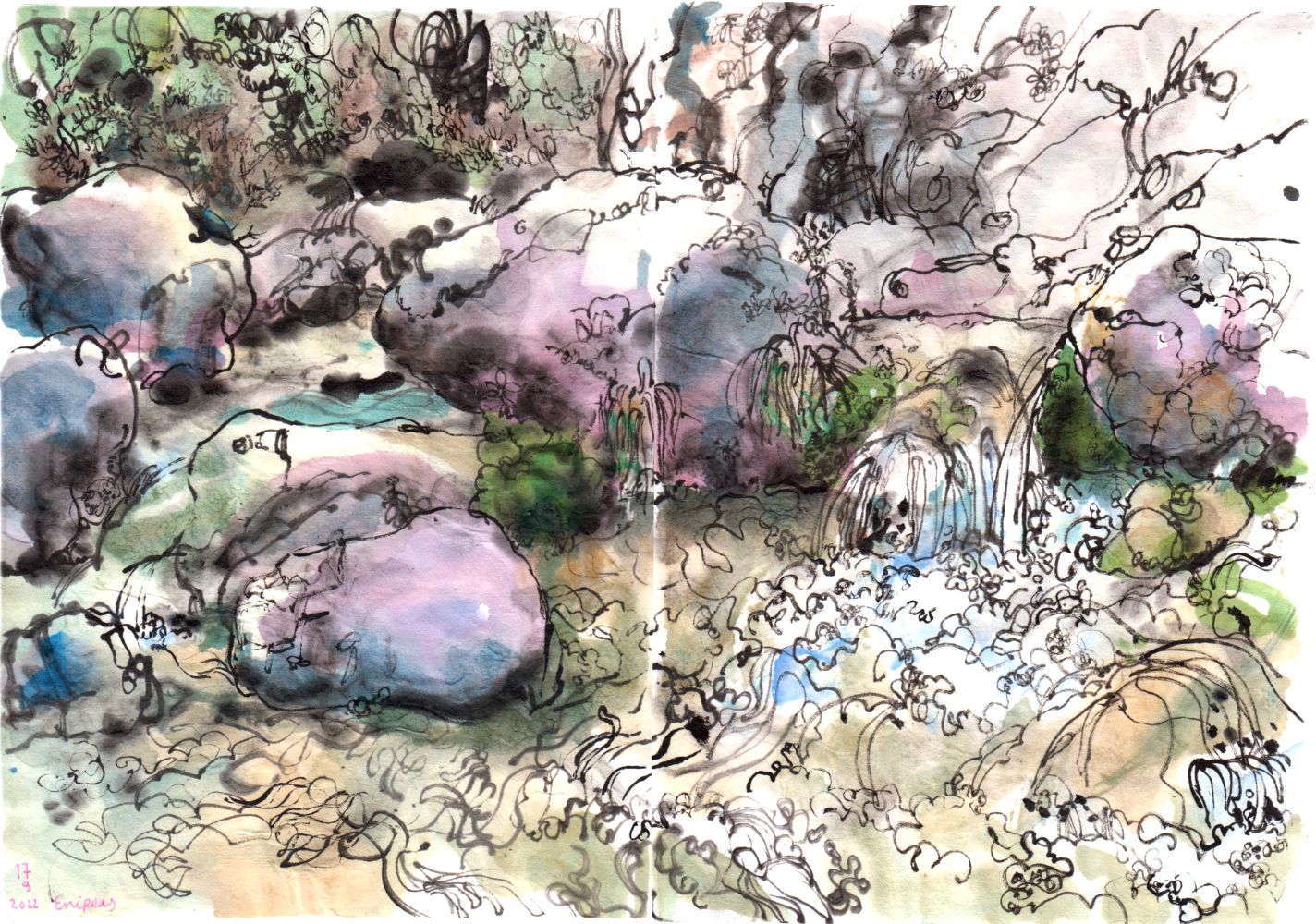
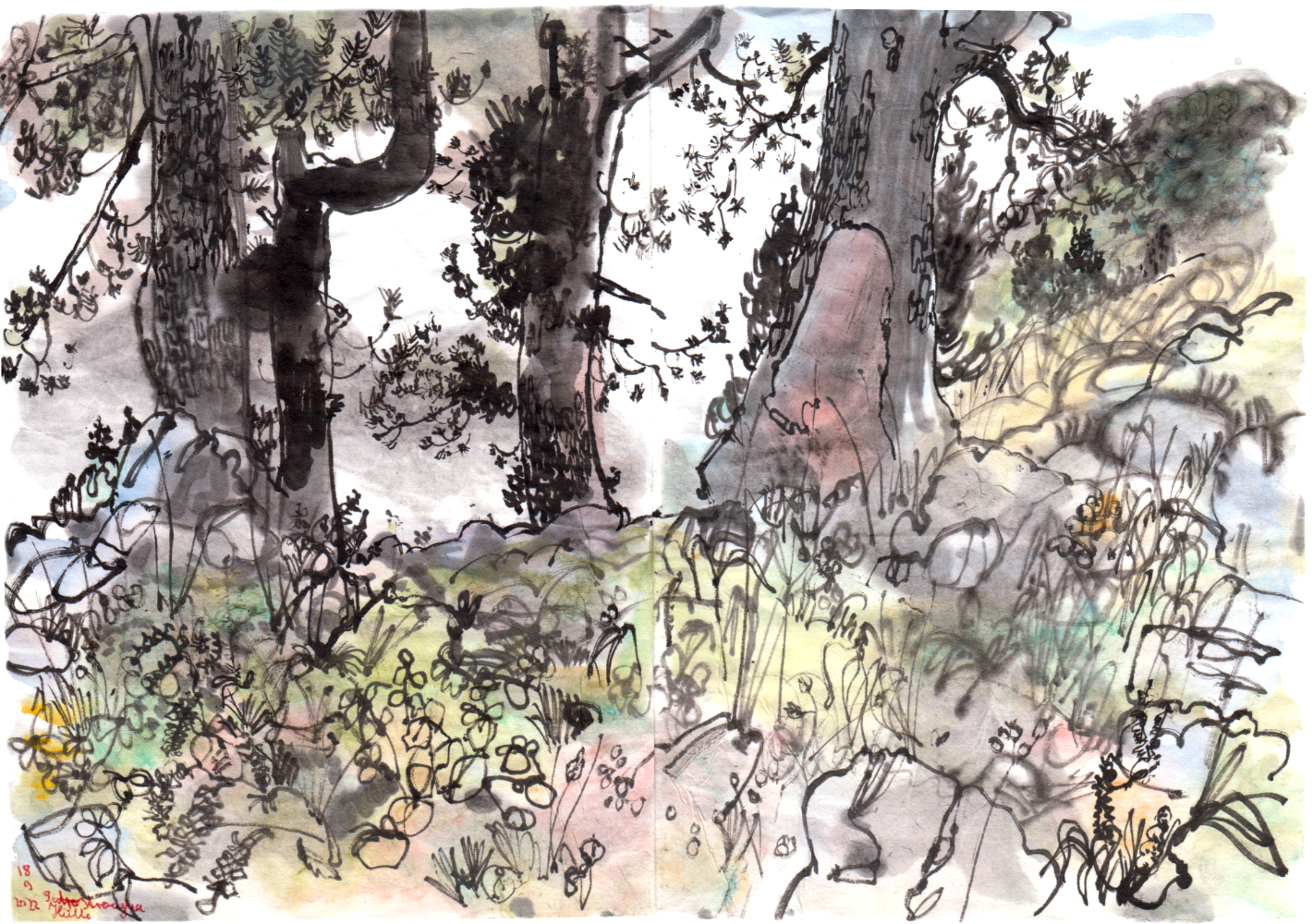
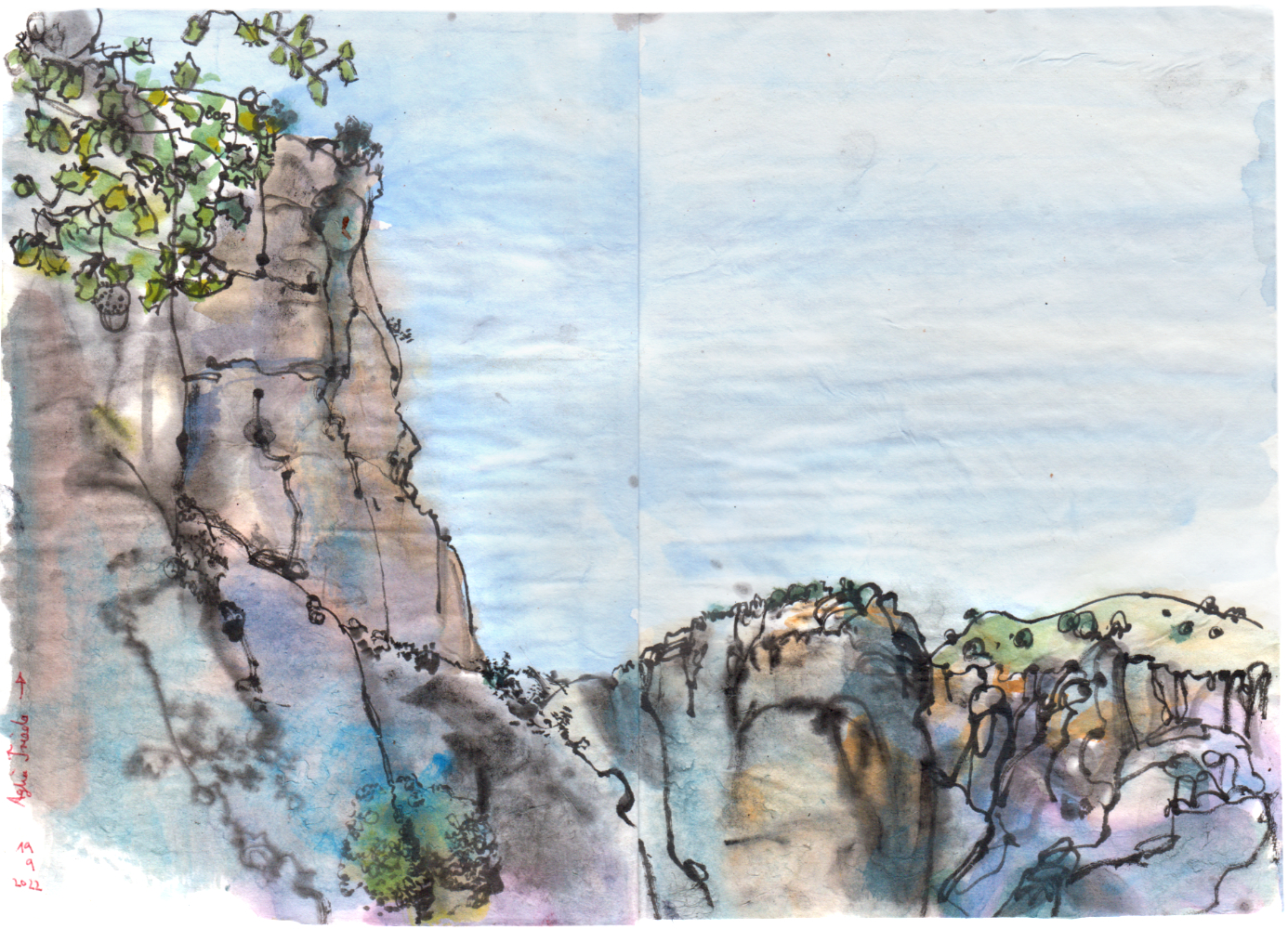
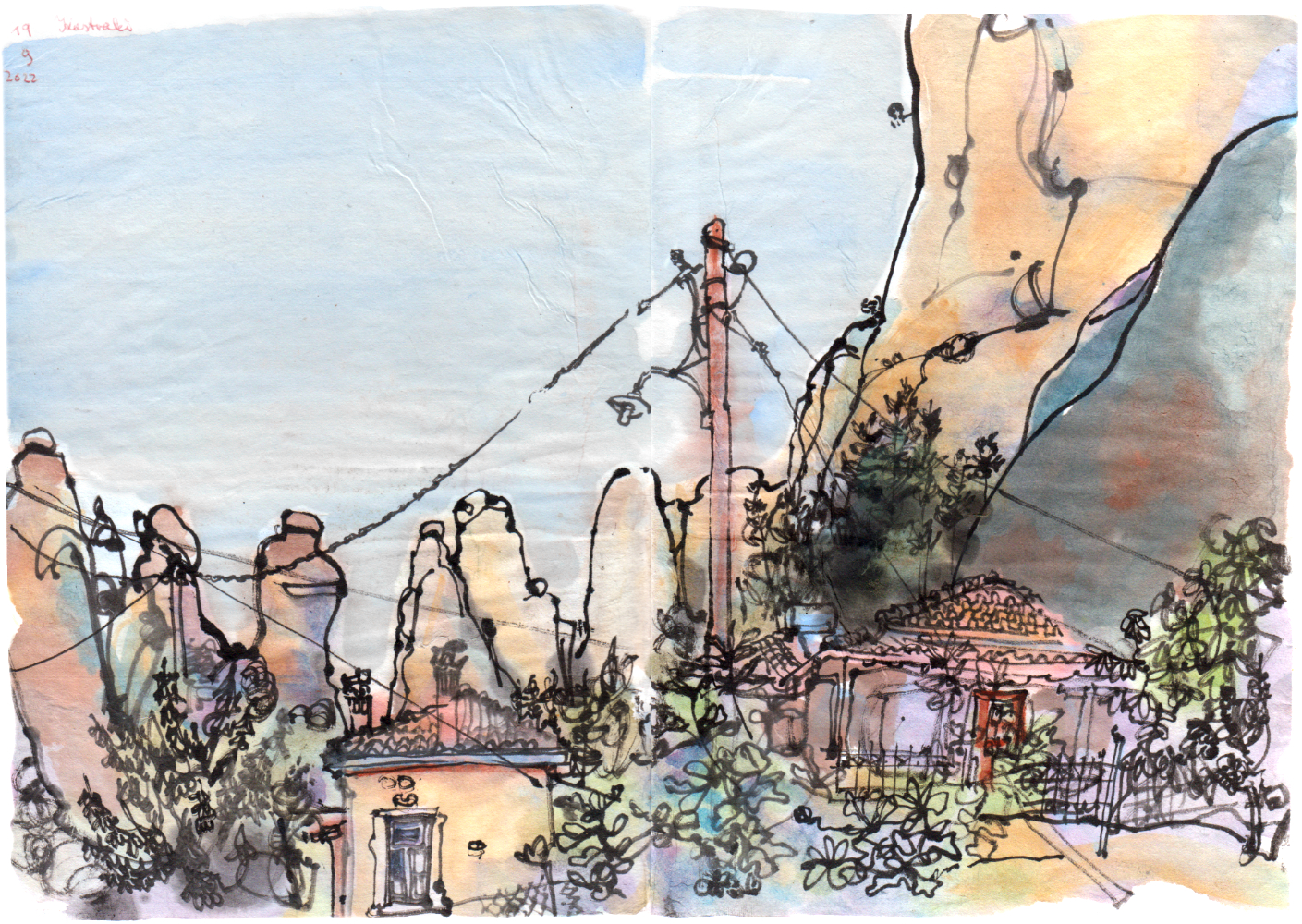
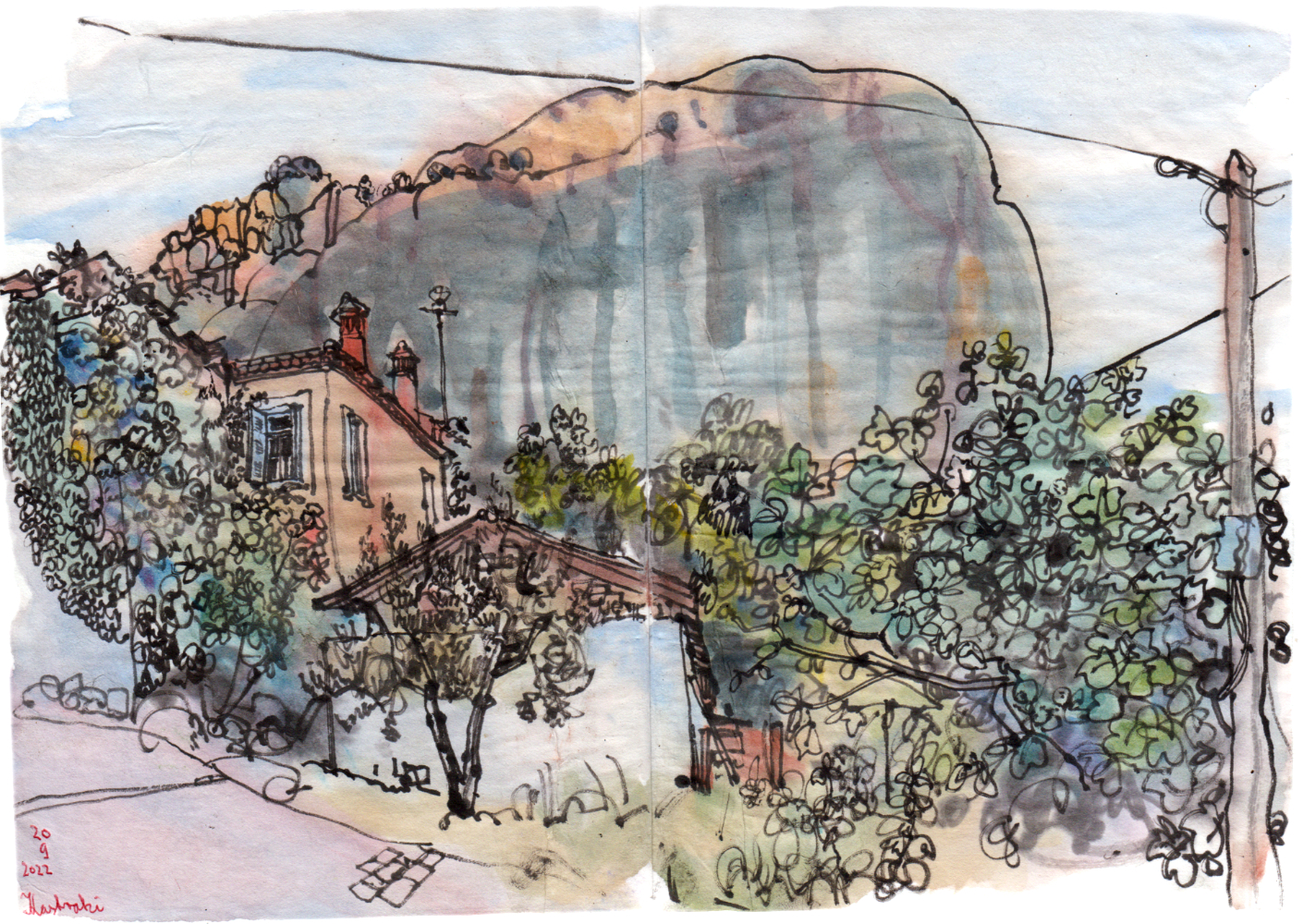
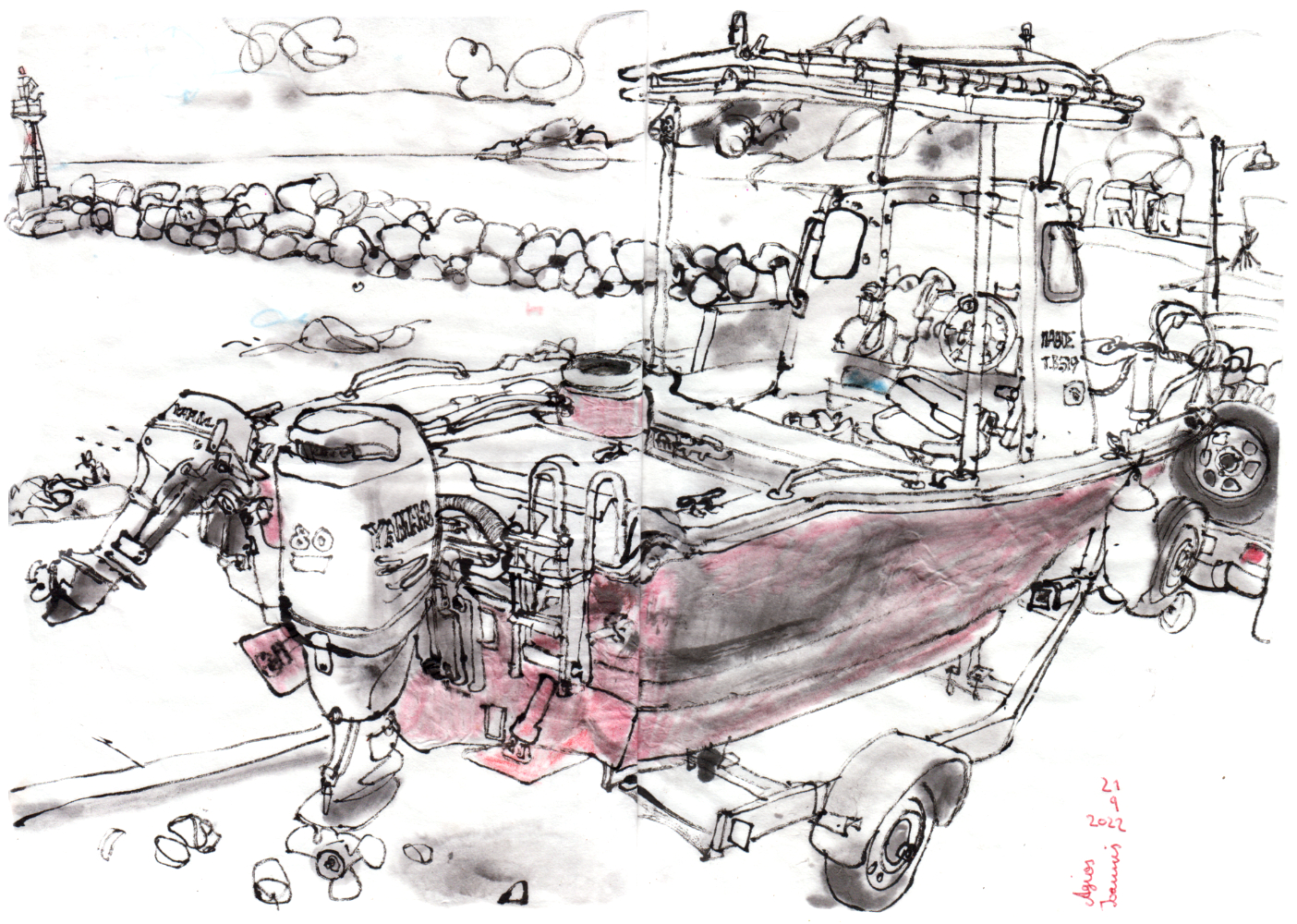
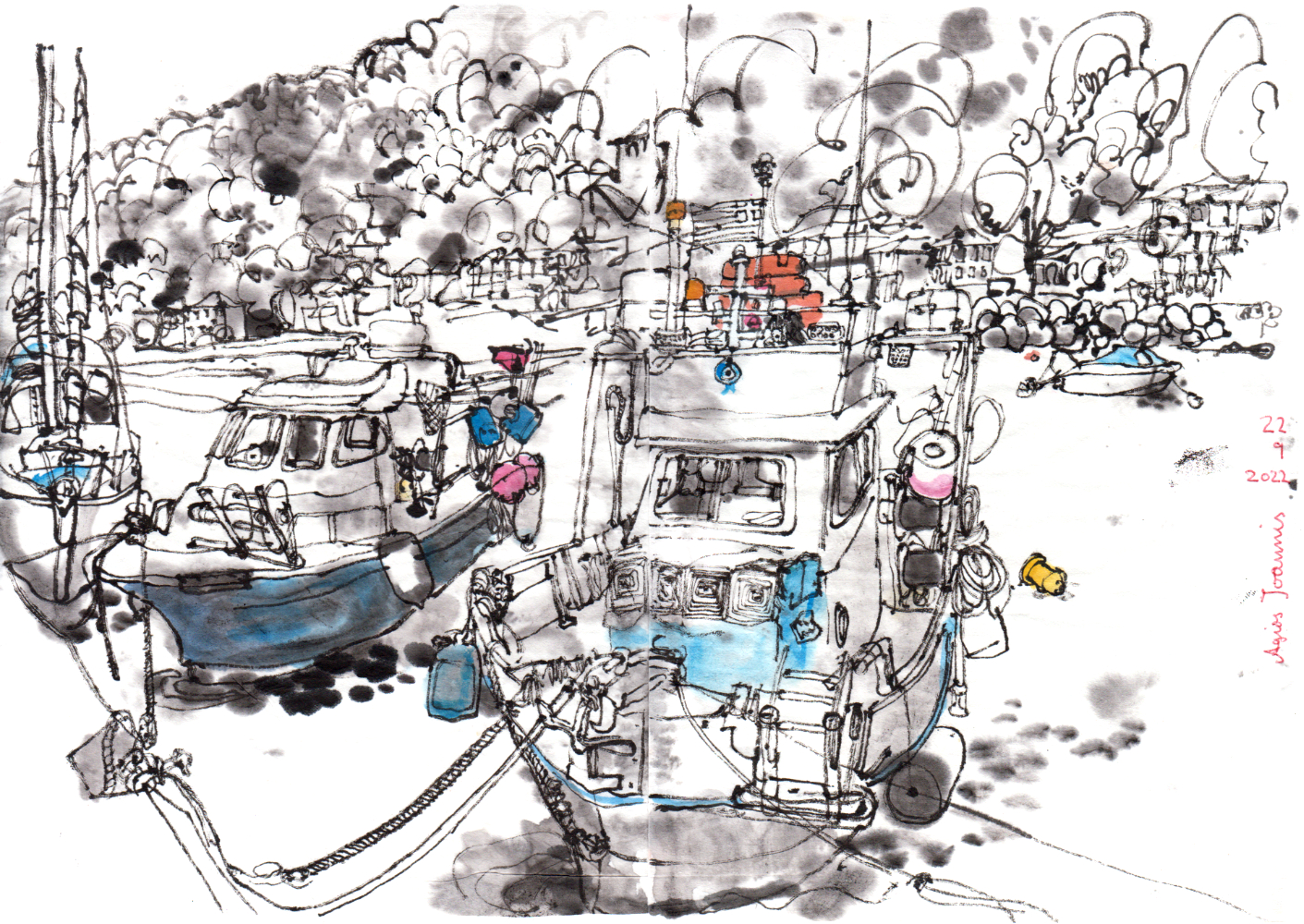

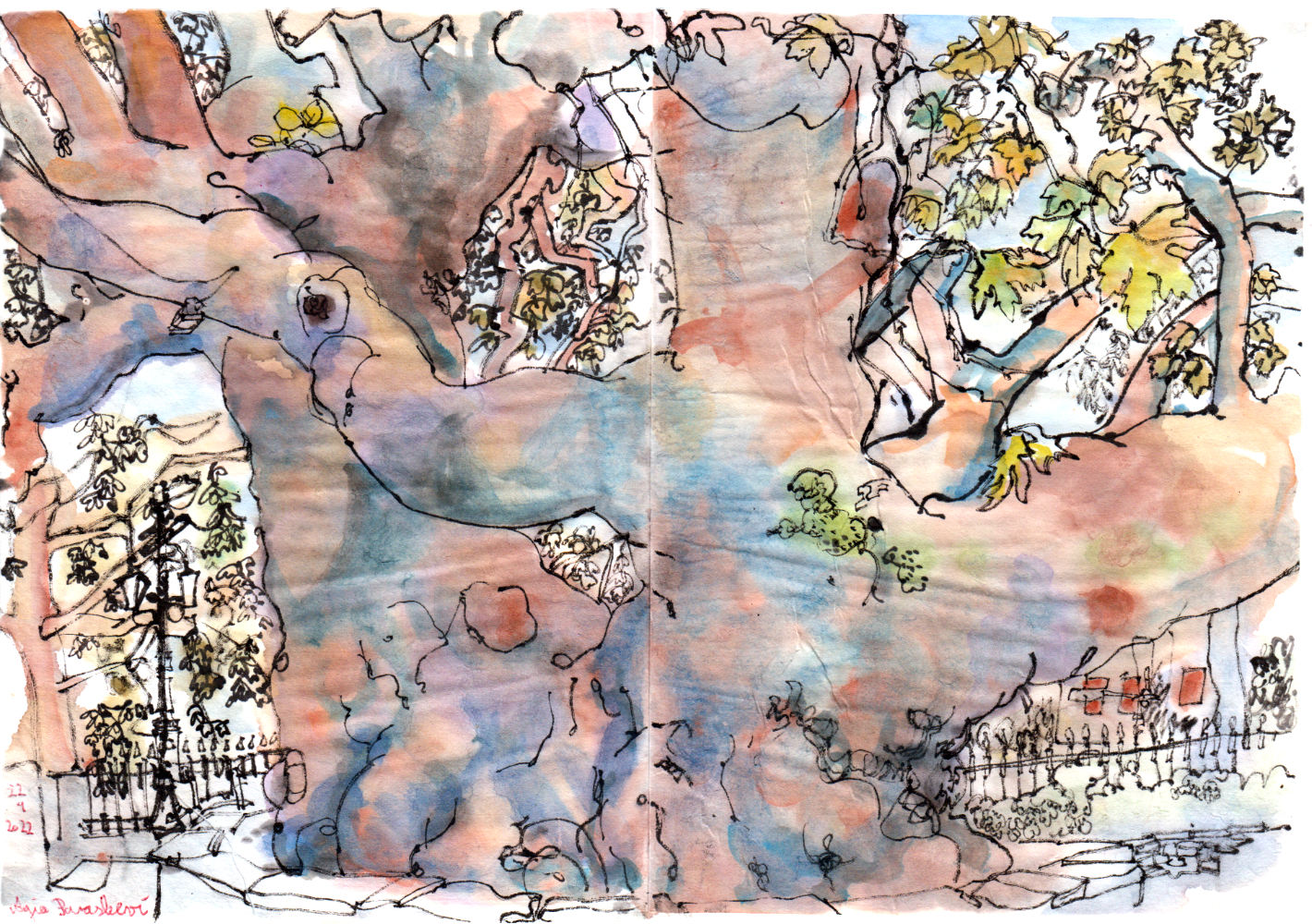
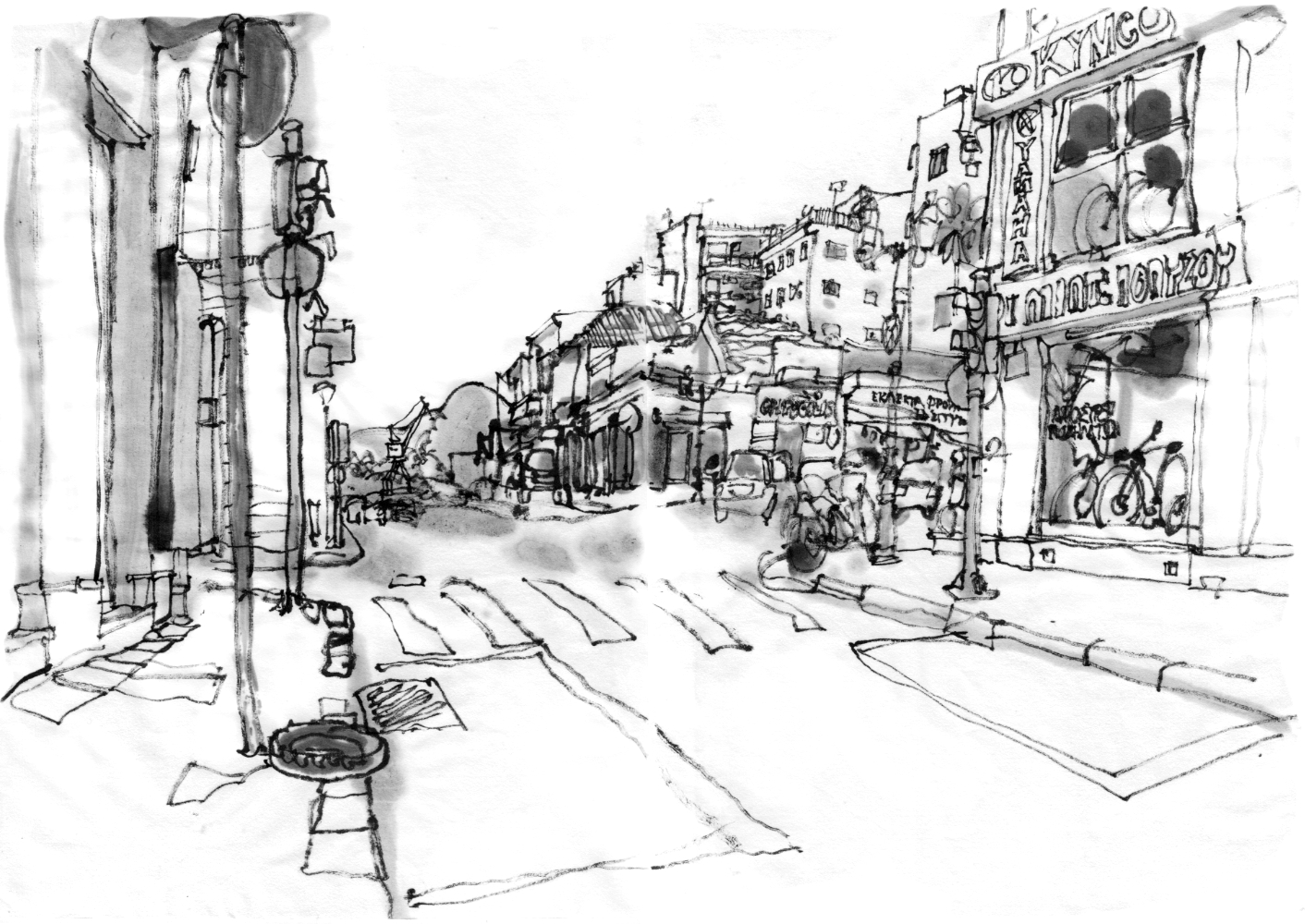
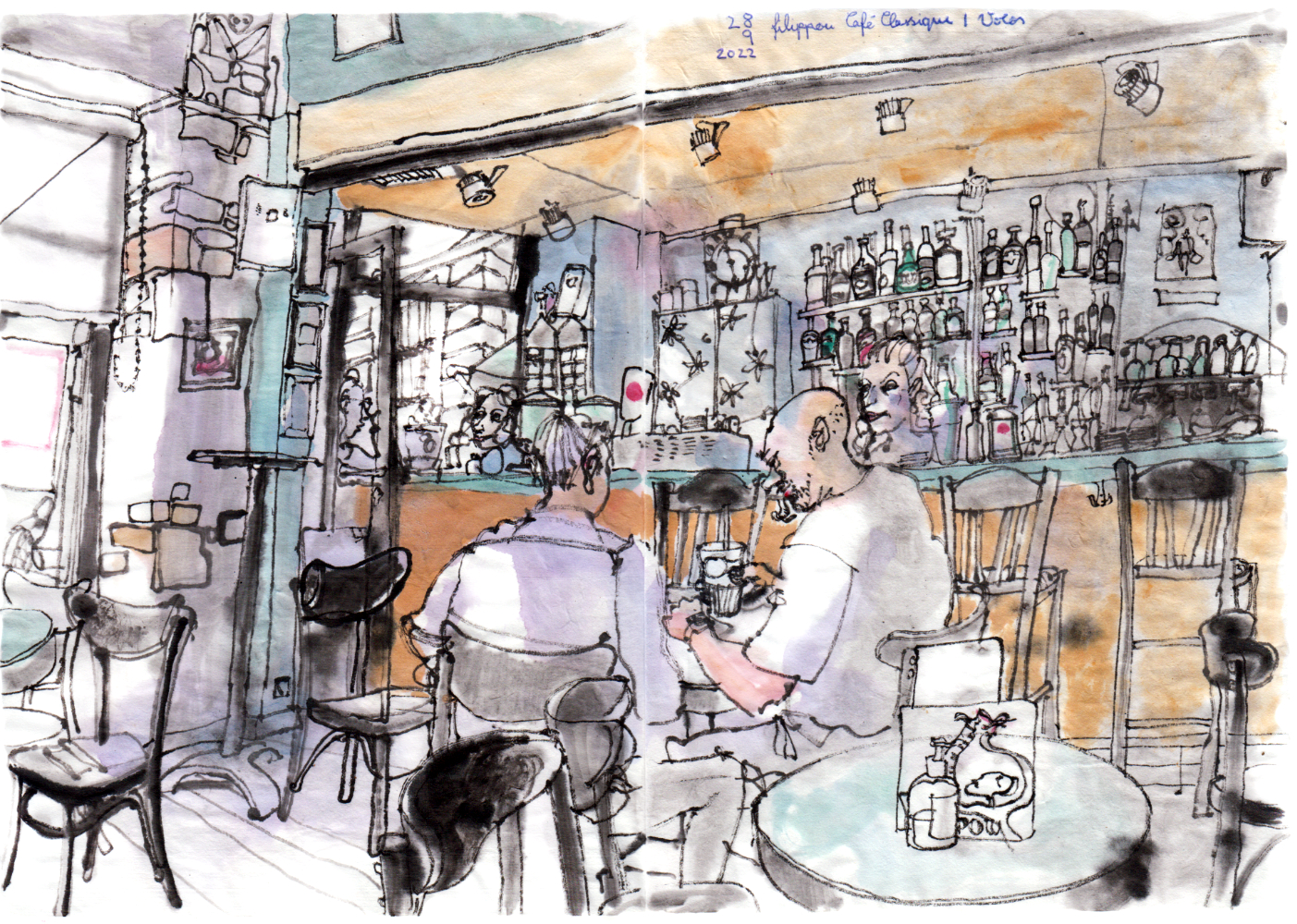
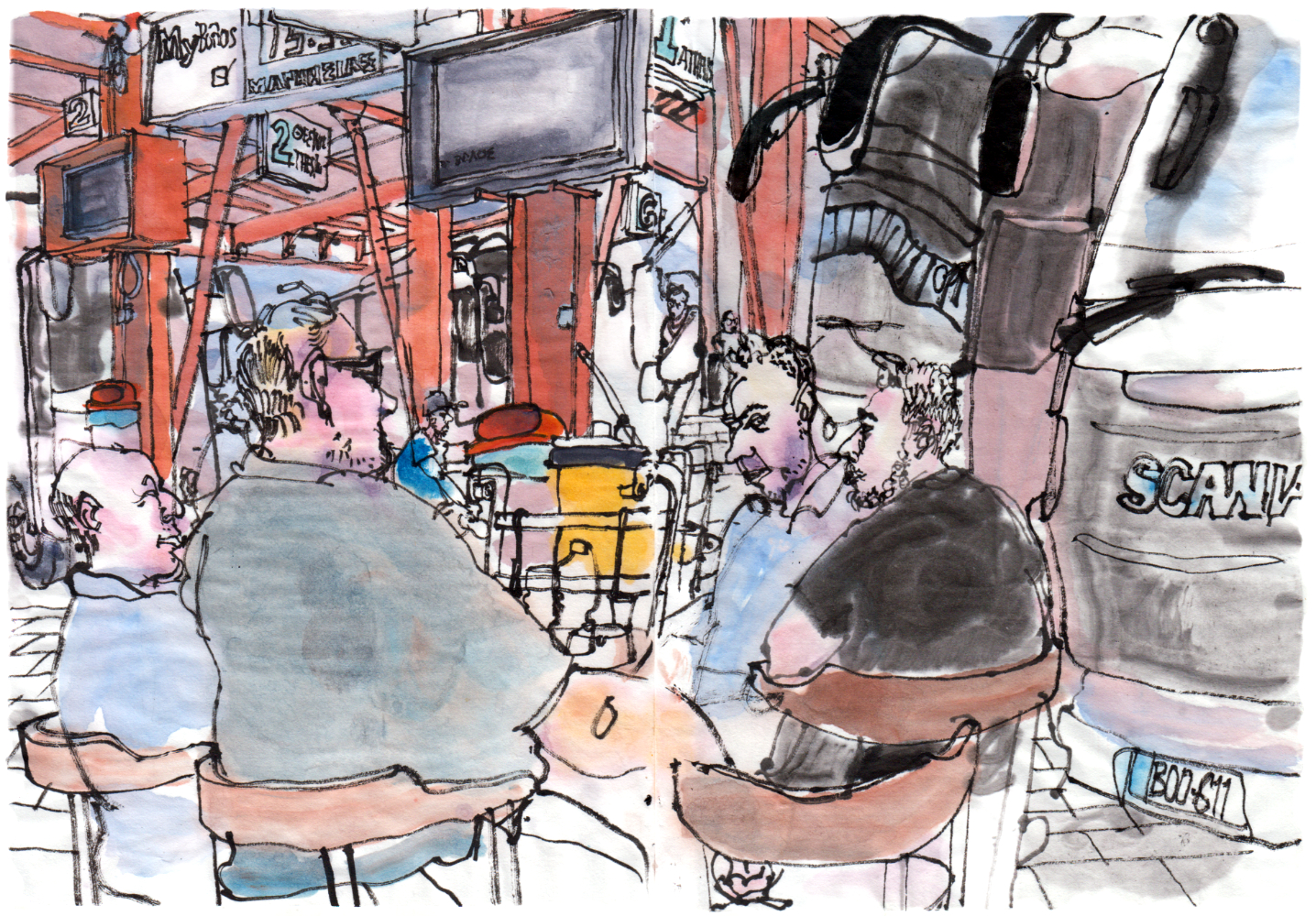
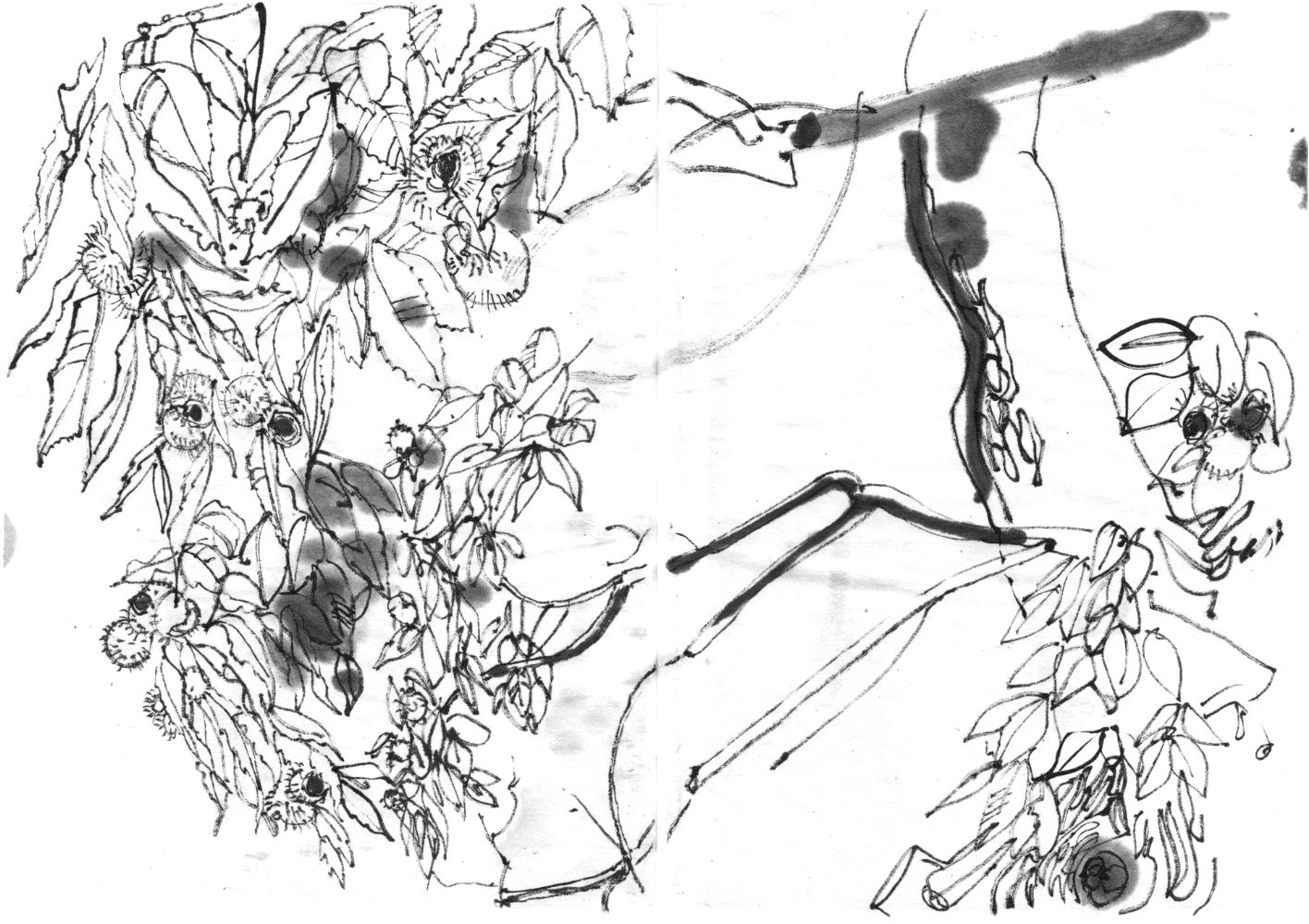
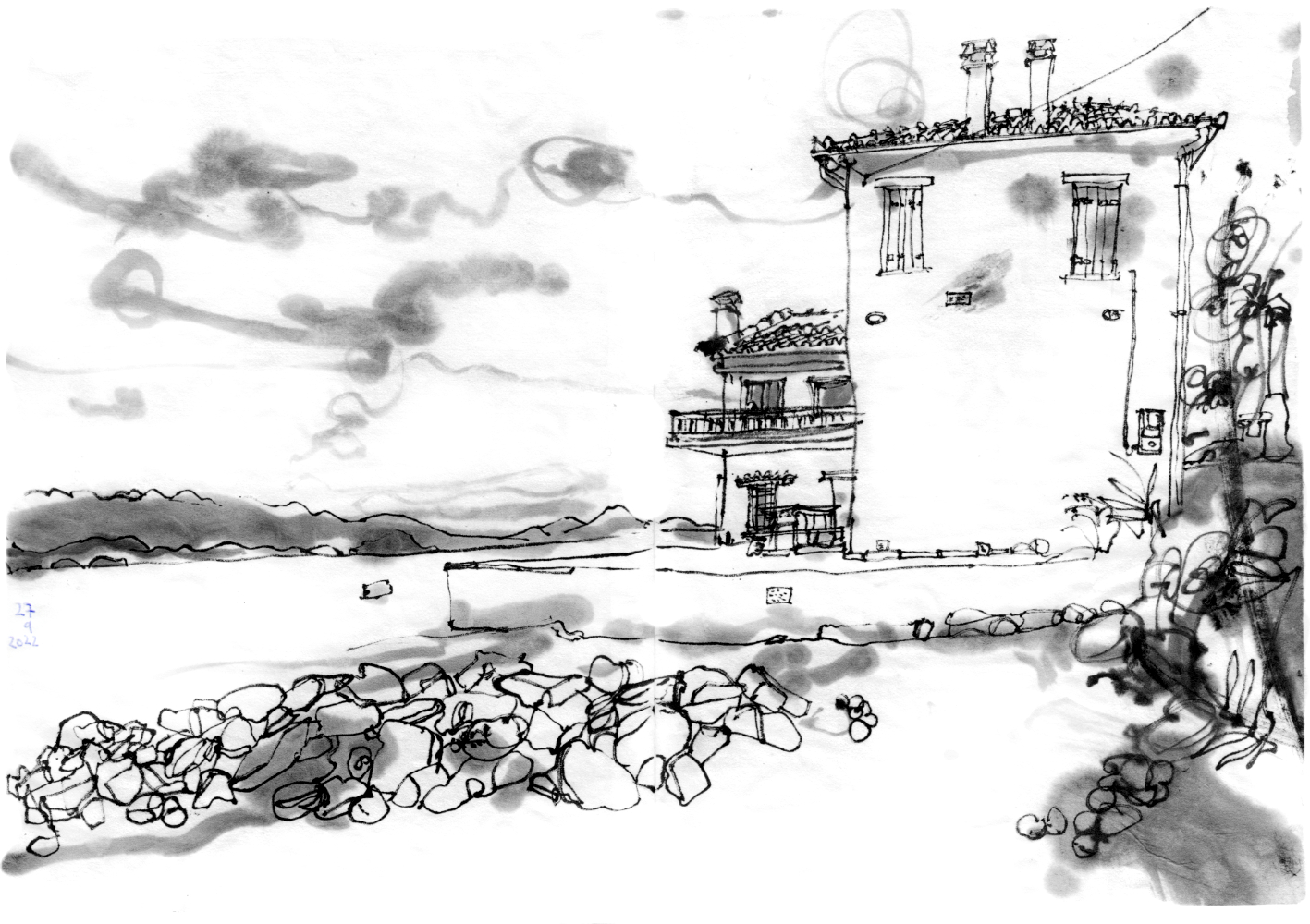
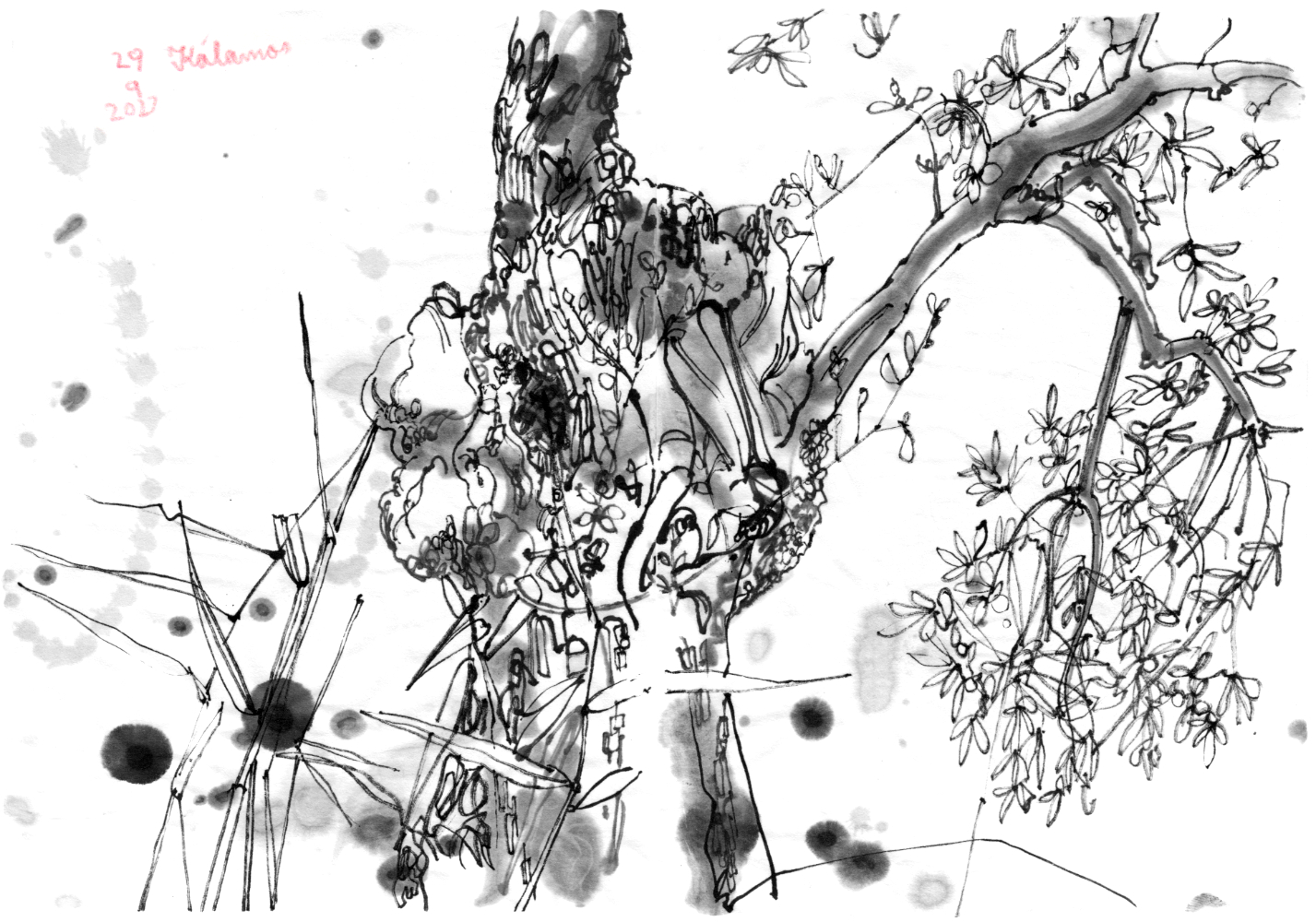
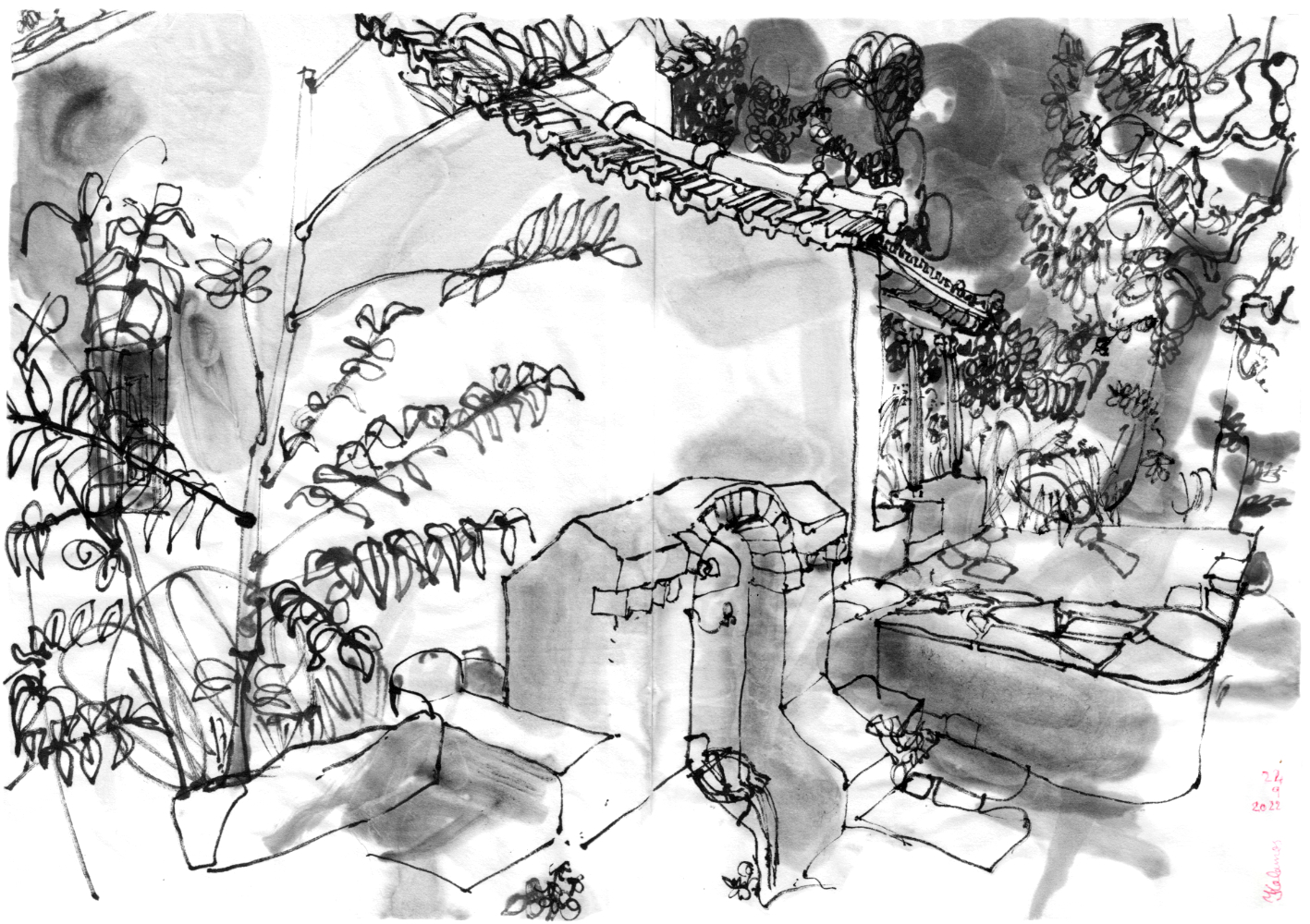
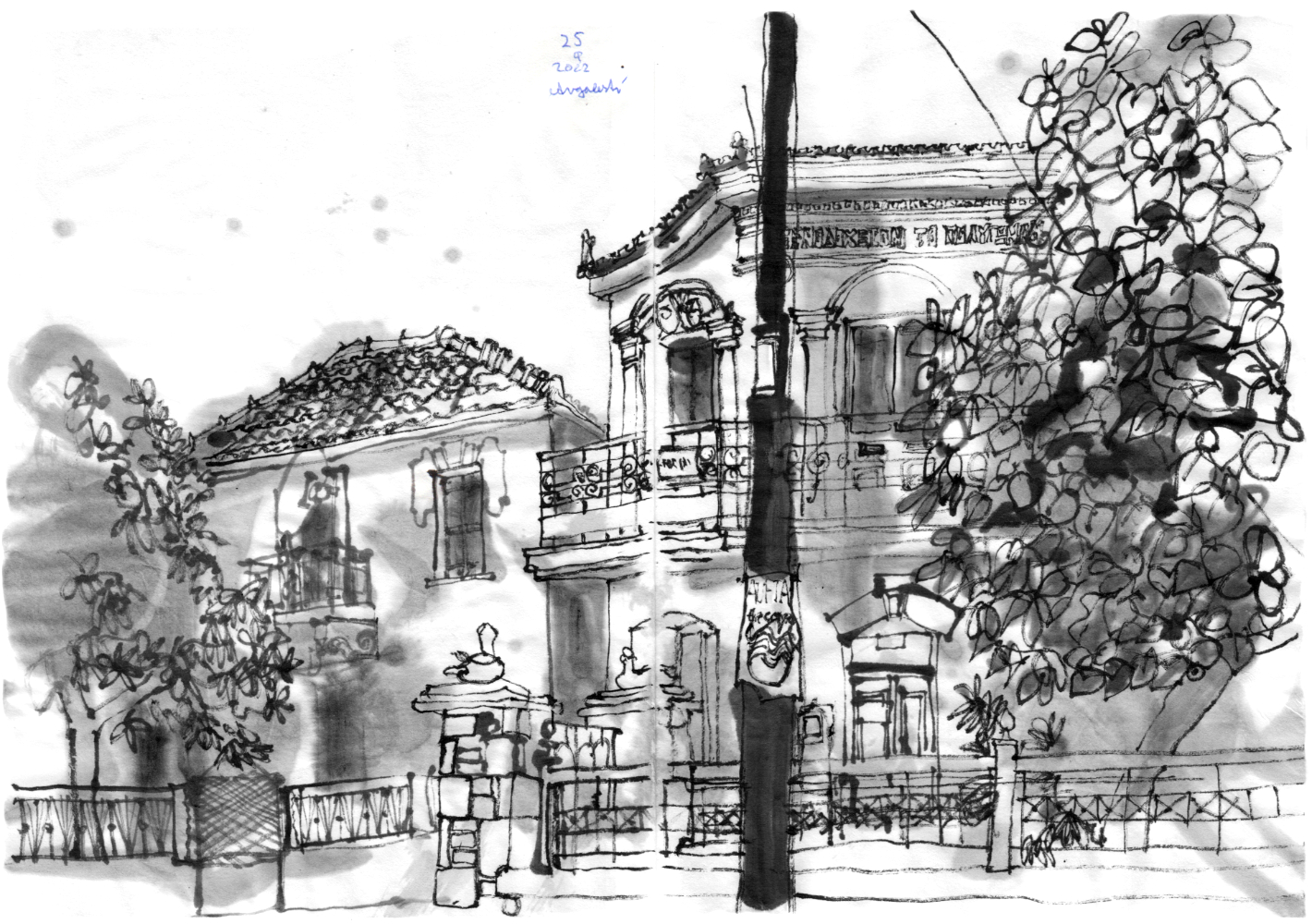
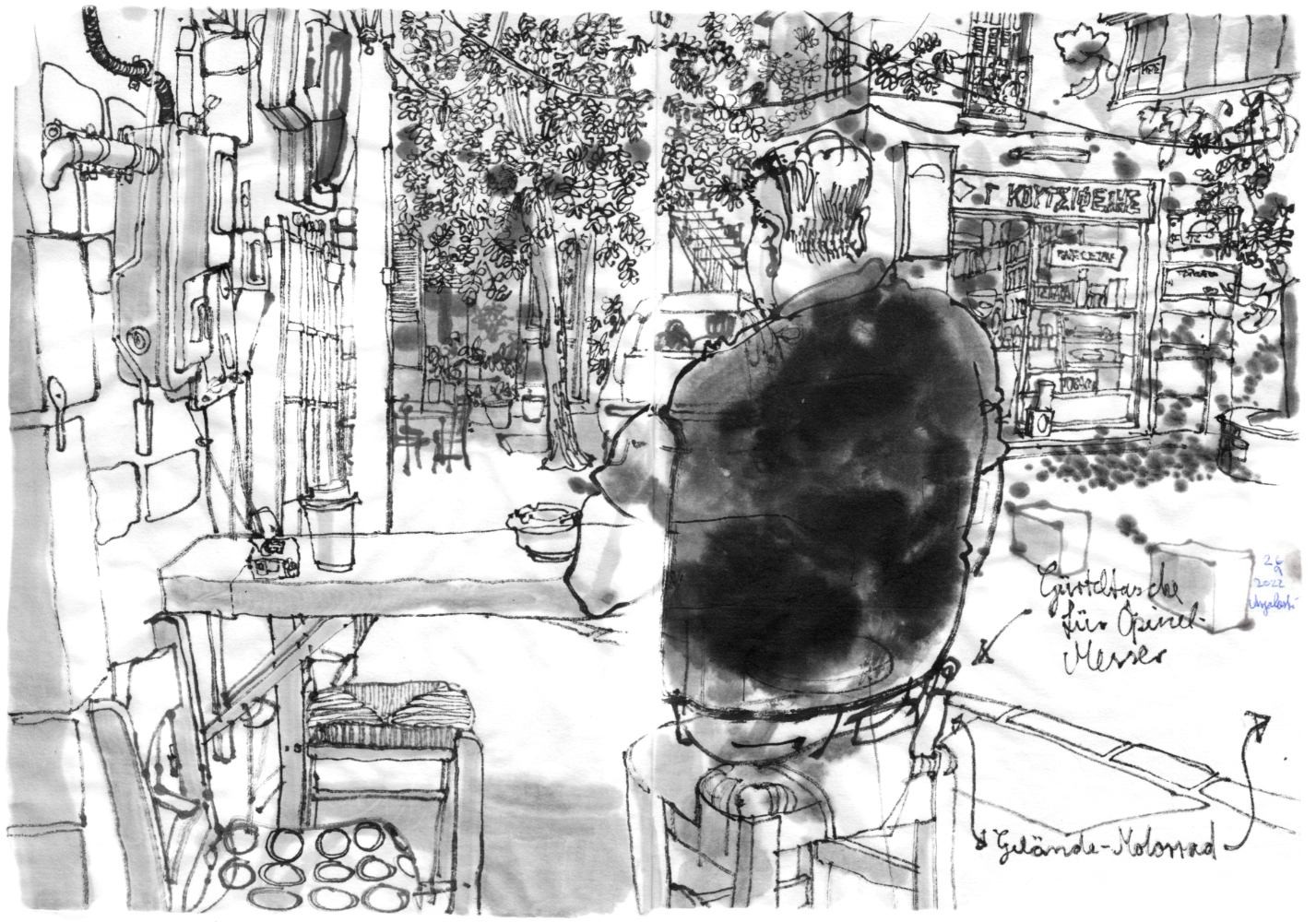

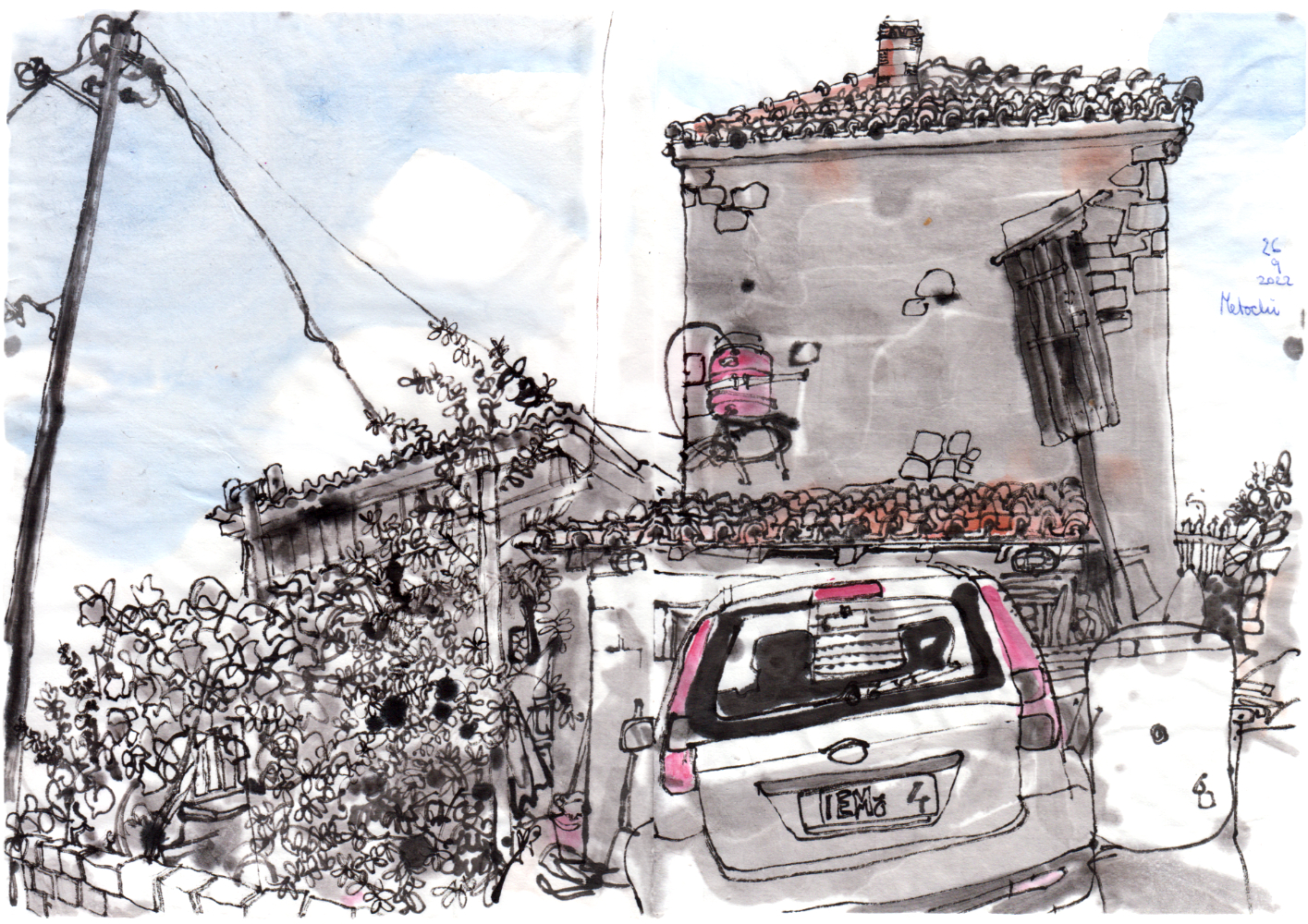
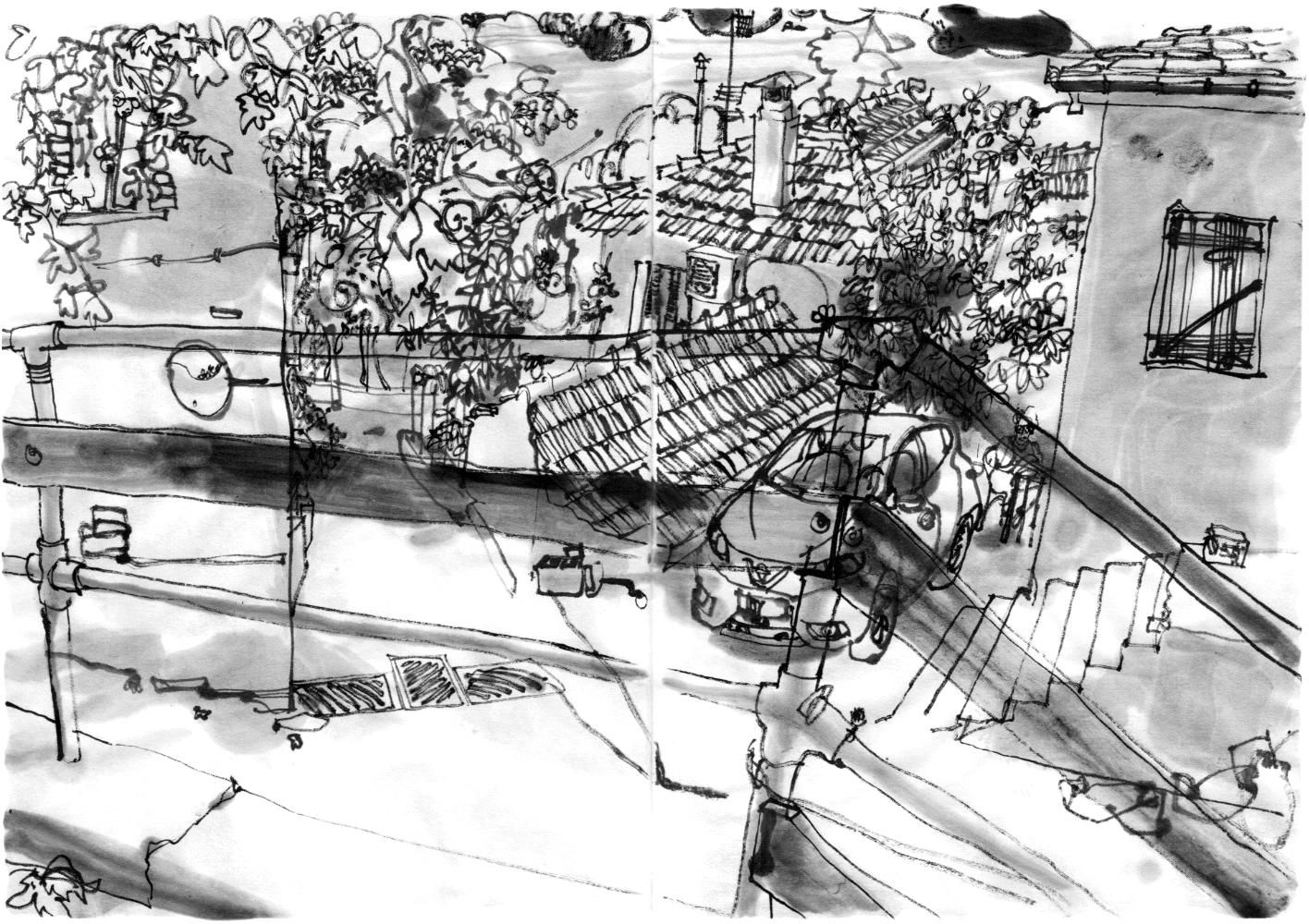
Leave a Reply